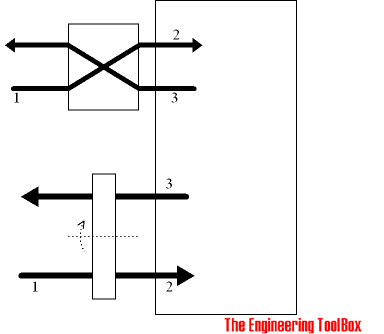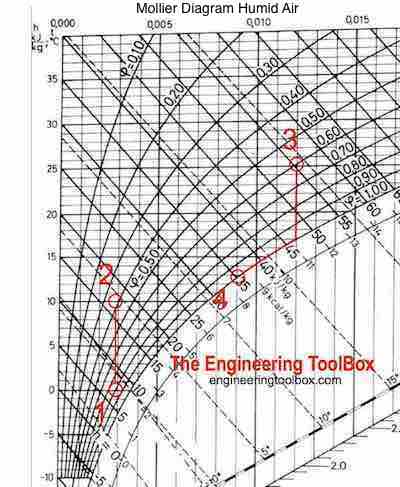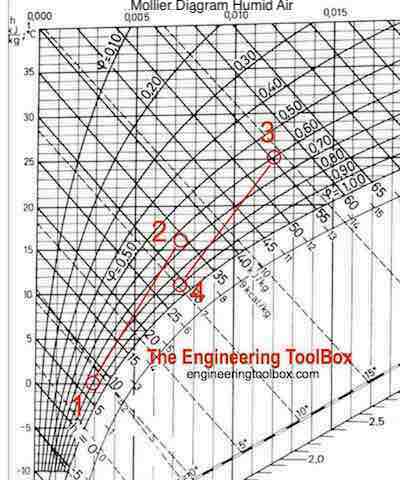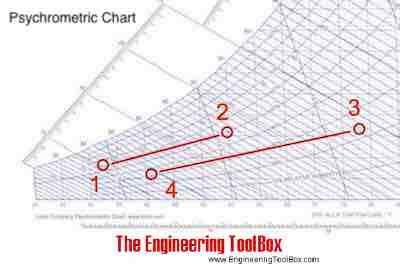Heat Recovery Efficiency
Classification of heat recovery efficiencies - temperature efficiency, moisture efficiency and enthalpy efficiency - online heat exchanger efficiency calculator.
Common Energy Recovery Principles
Heat recovery units used in ventilation and air condition systems are based on some common principles:
- Return air
- Rotating heat exchangers
- Air-Fluid-Air exchangers
- Cross flow exchangers
- Heat pumps
Cross flow and rotating heat exchangers are illustrated below:

Return Air Recovery Units
In a return air recovery unit - used air is mixed into the make-up or supply air. Energy in outlet air is supplied directly into the make-up air. Both sensible and latent (moisture) heat is transferred.
Rotating Heat Exchangers
In a rotating heat exchanger - outlet air heats (or cools) the exchanger when the wheel passes through the outlet air flow. The energy is transferred to the make-up air when the wheel passes through the make-up air.
Both sensible and latent heat may be transferred. Latent heat when moisture in the outlet air condensates on the wheel. More moisture may be transferred using a hygroscopic wheel. For exchangers without hygroscopic wheels most of the condensate is drained out.
Air-Fluid-Air Exchangers
In an air-fluid-air heat recovery unit - heat is transferred in an heat exchanger from the outlet air to a circulating fluid. The fluid is circulated to a heat exchanger in the make-up air where the heat is transferred to the supply air.
Both sensible and latent heat may be transferred. Latent heat when moisture in the outlet air condensates in the heat exchanger. The moisture is not transferred.
Cross Flow Heat Exchangers
In a cross flow heat exchanger - heat is transferred directly from the outlet air to the make-up air through the separating walls in the heat exchanger.
Both sensible and latent heat may be transferred. Latent heat when moisture in the outlet air condensates on the heat exchanger. The moisture is not transferred.
Heat Pumps
A heat pump makes it possible - with some additional energy - to move more outlet air energy to the make-up air than any other system. The energy consumption is approximately 1/3 to 1/5 of the recovered energy.
Both sensible and latent heat may be transferred. Latent heat when moisture in the outlet air condensates on the heat exchanger. Moisture is not transferred.
Heating Process - Recovery without Moisture Transfer
The heating process without moisture transfer with a recovery unit - typical like the cross flow unit in the figure above - can be visualized in a psychrometric Mollier diagram as

Heating Process - Recovery with Moisture Transfer
The heating process with moisture transfer and a recovery unit - typical like the rotating wheel unit in the figure above - can be visualized in a psychrometric Mollier diagram as

The heating process with heat and moisture recovery can alternatively be visualized in a psychrometric chart as

Temperature Transfer Efficiency
The temperature transfer efficiency for an heat recovery unit can be calculated as
μ t = (t2- t1 ) / (t3 - t1 ) (1)
where
μ t = temperature transfer efficiency
t1 = temperature in outside make-up air before the heat exchanger ( oC, oF)
t2 = temperature in outside make-up air after the heat exchanger ( oC, oF )
t3 = temperature in outlet air before the heat exchanger ( oC, oF )
Moisture Transfer Efficiency
The moisture transfer efficiency for an heat recovery unit can be calculated as
μm = (x2- x1 ) / (x3 - x1 ) (2)
where
μm = moisture transfer efficiency
x1 = moisture outside make-up air before the heat exchanger (kg/kg, grains/lb)
x2 = moisture outside make-up air after the heat exchanger (kg/kg, grains/lb )
x3 = moisture outlet air before the heat exchanger (kg/kg, grains/lb )
Enthalpy Transfer efficiency
The enthalpy transfer efficiency for an heat recovery unit can be calculated as
μ e = (h2- h1 ) / (h3 - h1 ) (3)
where
μ e = enthalpy transfer efficiency
h1 = enthalpy in outside make-up air before the heat exchanger (kJ/kg, Btu/lb)
h2 = enthalpy in outside make-up air after the heat exchanger (kJ/kg, Btu/lb )
h3 = enthalpy in outlet air before the heat exchanger (kJ/kg, Btu/lb )
Related Mobile Apps from The Engineering ToolBox 
- free apps for offline use on mobile devices.
Heat Exchanger Efficiency Calculator
The calculator below can be used to calculate temperature, moisture or enthalpy efficiency for an heat exchanger - both Imperial and Metric units. The heat (kW) exchanged calulation is valid for metric units.
Related Topics
-
Air Psychrometrics
Moist and humid air calculations. Psychrometric charts and Mollier diagrams. Air-condition systems temperatures, absolute and relative humidities and moisture content in air. -
Ventilation Systems
Design of systems for ventilation and air handling - air change rates, ducts and pressure drops, charts and diagrams and more.
Related Documents
-
Air - Heating, Cooling, Mixing, Humidifying or Dehumidifying Processes
Basic air changing state processes - heating, cooling, mixing, humidifying and dehumidifying by adding steam or water - psychometric diagrams and the Mollier charts. -
Air - Humidifying by Adding Steam or Water
Air can be humidified by adding water or steam. -
Air Heating Systems
Air heating buildings - heat supply vs. air flow and temperature. -
Cooling Tower Efficiency
Maximum cooling tower efficiency is limited by the cooling air wet-bulb temperature. -
Dry Bulb, Wet Bulb and Dew Point Temperatures
Dry Bulb, Wet Bulb and Dew Point temperatures can be used to determine the state of humid air. -
Efficiency
The measure of usefulness. -
Efficiency
Efficiency is the ratio useful energy output to energy input. -
Energy Transfer Equation
Fluid energy transfer. -
Heat Exchangers - Overall Heat Transfer Coefficients
Overall heat transfer coefficients in common heat exchanger designs - tubular, plate or spiral. -
Heat Loss from Buildings
Overall heat transfer loss from buildings - transmission, ventilation and infiltration. -
Heat Recovery
Ventilation and heat-recovery calculations, sensible and latent heat - online calculators - imperial units. -
Humid Air - Heating
Enthalpy change and temperature rise when heating humid air without adding moisture. -
Latent Heat Flow
Latent heat is the heat when supplied to or removed from air results in a change in moisture content - the temperature of the air is not changed. -
Mixing of Humid Air
The change in state wwhen mixing moist air - enthalpy, heat, temperature and specific humidity. -
Moist Air - Cooling and Dehumidifying
Cooling and dehumidifying processes of moist and humid air - sensible and latent cooling. -
Moist Air - Enthalpy
Sensible and latent heat of moist air. -
Moist Air - Properties
Psychrometric table with humid air properties like saturation pressure, specific volume, enthalpy and entropy. -
Moist Air - Psychrometric Chart for Low Temperatures at Sea Level
Psychrometric chart in I-P Units for low temperature at sea level and barometric pressure 29.921 inHG. -
Moist Air - Psychrometric Table for Pressure 29.92 inHg
Dry and wet bulb temperatures, saturation pressure, water vapor weight, specific volume, heat and more. -
Moist Air - Psychrometric Terms
Dry and wet bulb temperature, specific volume, relative humidity, enthalpy and more. -
Moist Air - the Mollier Diagram
The Mollier diagram is a graphic representation of the relationship between air temperature, moisture content and enthalpy - and is a basic design tool for building engineers and designers. -
Moist Air - Transforming the Mollier Diagram to a Psychrometric Chart - or vice versa
The relationship between the psycrometric chart and the Mollier diagram. -
Moist Air - Weight of Water Vapor
Weight of water vapor in air -
Outdoor Supply Air Rates
Recommended supply air rates of outdoor air - with or without smoking - in rooms like banks, assembly halls, hotels and many more. -
Power Plants - Performance Efficiencies
Power plants heat rates, thermal efficiencies, capacity factors, load factors, economic efficiencies, operational efficiencies and energy efficiencies. -
Sensible Heat Ratio - SHR
The ratio Sensible Heat (or Cooling) Load to the Total Heat (or Cooling) Load.




